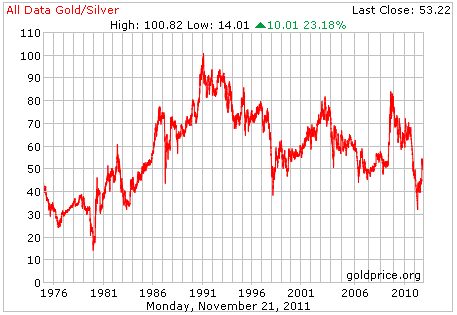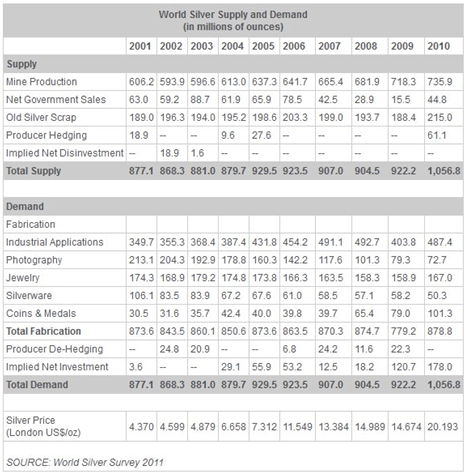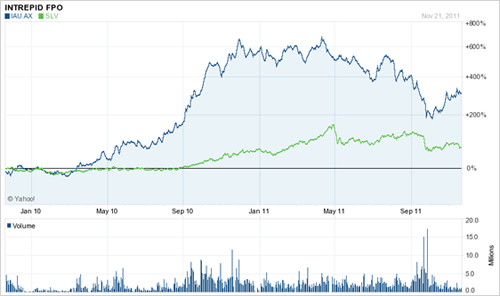Many precious metal investors prefer silver over gold? Why might silver be a good alternative and what are some common investment vehicles to invest in silver with?
Why Buy Silver?
Many investors buy silver when gold is rising as these two precious metals often trade as a correlated team. This is the basis for the gold/silver ratio that plots the comparative values between the two metals. When the ratio is high, some say silver is undervalued compared to gold. Others suggest that silver has been undervalued for a very long time and that the silver to gold ratio should average less than 20.

Others point to current supply and demand issues to build the case for buying silver. Total demand has risen over 20% in the last decade. While demand for silverware and photography are declining, industrial applications are trending up overall, as is coin and medal collecting. In addition to these demands driving live silver prices upwards, there are some emerging uses for silver that include medical applications, mirrors and coatings, solar energy, and water purification.

Still others want to use silver as a hedge against the market or as a diversification tool for an investment portfolio. Regardless of your reasons for wanting to trade silver, what are the methods in which you may do so?
How do I invest in silver?
What are the common methods for you to gain exposure to silver? We will consider a few instruments at your disposal.
Silver Bullion Bars. Silver bars come in various sizes. The 1000 ounce silver bar is regarded as the industry standard for trading. Smaller bars of 100 ounces are more common for individual purchases. Before buying bullion you will want to consider the bar size (from 1 to 1000 ounces), and the fineness. 99.9% pure silver is the standard. As well, examine the current market price versus the price you are paying as a premium that is added by the dealer. You will also need to decide where to store your silver – such as a bank, a rented safe, or other storage facility. This will add some cost. You can examine the silver bullion prices at the Perth Mint Australia as a benchmark.
Official Coins and Medallions. An alternative to holding silver bullion bars is with official coins or through government or private minted medallions. You can buy and sell coins at the Perth Mint. Keep in mind that medallions are unofficial rounds which resemble coins but are not considered legal tender.
Certificates. Do you want to have exposure to physical silver but do not want the hassle of finding a local facility to store and protect it? Buying silver certificates is one way to own silver without the storage problems. The Perth Mint Certificate Program (PMCP) allows you to buy allocated, pool allocated, or unallocated silver. You can skirt the storage fees through unallocated silver certificates, but some prefer the comfort of knowing that their silver is already mined and is being held in a vault somewhere for quick possession. Your certificate entitles you to sell it back to an approved dealer, or to take physical possession of the silver at a future date.
Accumulation Programs. Are you a long-term bull on silver but are unsure whether today’s prices make a good entry or not? If this describes you, making use of an accumulation program might be prudent. Some silver firms allow for regular and automatic purchases towards the precious metal. Doing so makes use of dollar cost averaging. As an example, SilverSaver allows customers to buy $25 of precious metals per week. You can do this yourself without a program but you’ll need to make sure that fees are extremely low so your cost-averaging scheme is not consumed in high acquisition costs. If you decide to go with an accumulation plan, you will need to examine each company offering it to ensure whether you are buying exposure to silver price movements or whether you can physically take possession of silver if desired.
Silver Futures. Another method to gain exposure to silvers’ changing price, or to get a large amount of physical silver all at once, is to use silver futures contracts. A standard silver futures contract will be 5,000 troy ounces. Multiply this by silver prices of $30 or more and you can quickly calculate how much capital you will need to take delivery of this shipment. An e-mini silver futures contract is 1,000 troy ounces and the COMEX miNY silver futures contract is 2,500 ounces. You will need $5,000 to $25,000 in initial margin to trade these products depending on the size of contract. If you are speculating on fluctuating silver prices, you can buy and sell these contracts before exercise date.
Silver Shares/Stocks. Instead of the direct investment into silver, some prefer to invest in a company engaging in exploring, mining, and producing silver Investigator Resources Ltd (IVR) or Intrepid Mines Limited (IAU). The chart below compares Intrepid to a silver price tracking fund. As you can see, company shares may at times move at a geared ratio to the underlying price of silver. If you are a silver price bull or think that current prices will provide high profit margins for a company mining it, trading the shares can be a good way to gain indirect exposure.

Funds. Then we have various managed funds and exchange-traded funds that give exposure to silver. These funds vary greatly and you’ll need to examine each fund to determine whether it is suitable for your investment needs. Some funds, such as iShares Silver Trust, attempts to mirror the price of the silver per ounce. Other funds will leverage the price by two or three times the daily movement for short-term trading. Other funds will short the price of silver. Still other funds will invest in a basket of silver mining companies. Funds will rarely allow you to exercise the shares for physical silver, but they do allow you to have varying degrees of exposure to different aspects of the silver industry.
Contracts For Difference. Some brokers allow you to trade Contracts For Difference (CFDs) on silver. One variation is to have full or mini contracts (worth 10% of the main size) that have no expiration date. Each point is worth $1 AUD, and you can open a position with 5% margin. The difference between these CFDs and a futures contract is that you are trading current spot prices instead of anticipated future prices – and there is never a physical delivery of silver and there is no expiration date with CFDs. This is a leveraged method of trading current silver valuations.
Options. Options are a derivative of funds, futures, and shares. Instead of buying futures contracts, exchange-traded funds, or silver shares, you can buy options in them. Why buy options? First, you have limited risk in that you cannot lose more than you invest. The same cannot be said of futures contracts or CFDs which can see you losing more than your initial margin. The downside to options is that they may expire worthless if certain conditions are not met, and there is time value built into them meaning that they lose a certain amount of extrinsic value with each passing day. In addition to guessing the right direction of silver prices, you need to have a big enough price move to beat the additional time decay premium. You can sell your contract early or wait until exercise date.
Investing in Silver
There are many reasons to invest in silver – from diversification of portfolio to having physical currency if the world’s fiat currency market falls apart. There are no best ways to invest in silver, your choice of vehicle will depend on whether you are using it as a strategy to hedge, in case the banks and stock markets fail, or if you are making small leveraged bets as hobby.
Is it a good time to invest in silver now or is it too late? Many analysts, including BNP Paribas believes silver will hit $100 in 2012. While this may or may not happen, in time there will no doubt be more investment opportunities in silver to add to this already large list of opportunity.